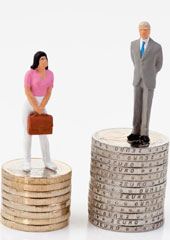Is the Gender Pay Gap Closing?
Which country performs best in terms of equal pay — US, UK, Germany or Korea?
February 16, 2014

For decades, there has been talk of equal pay for equal work. However, for all the progress that has been made regarding the advancement of women in the workplace, women are still likely to be paid significantly less for the same work than men.
Which of the following countries performs best in terms of equal pay?
A. South Korea
B. Germany
C. United Kingdom
D. United States
A. South Korea is not correct.
The gender pay gap — defined by the Paris-based Organization for Economic and Development Cooperation (OECD) as the percentage by which the median earnings of women falls short of men for full-time employment — has been a stubbornly persistent problem in Asia.
In fact, South Korea — the world’s 15th-largest economy — has by far the highest pay gap between men and women of the 28 advanced economies tracked by the OECD. In 2010, men received a median wage that was 39% higher than women who worked full time. This was barely changed from the 40% difference that prevailed in 2000.
Japan — the third-largest economy in the world — has the OECD’s second-highest gender pay gap. There, full-time working women earn nearly 28% less than their male counterparts.
In Korea, there is also a pronounced difference in women’s earnings relative to men depending on whether they have children or not. Childless women earn just 13% less than men. The gap rises to 45% for women who have children. Korean women are traditionally expected to abandon their careers after marriage and starting a family.
B. Germany is not correct.
Despite having Europe’s best-performing economy, Germany has the third-highest gender pay gap among the 28 advanced economies of the OECD — and the highest among Europe’s major economies.
Based on data for 2010, Germany’s full-time female workers earn almost 21% less than men. A decade earlier, in 2000, the gap was 24%.
Worldwide, one of the primary reasons for the persistence of the gender pay gap is the traditional idea of men as the family breadwinner — and therefore ought to receive higher pay than a woman, even when performing the same job.
However, the effects of the pay gap can have serious consequences beyond simple unfairness. Wage inequality is especially dire for women who are single parents, for example. Children of single mothers are more likely to grow up in poverty and have fewer educational opportunities.
Wage inequality over the course of a working life can also lead to far lower levels of retirement savings, putting women at greater risk of poverty in their old age.
C. United Kingdom is correct.
The United Kingdom’s gender pay gap of just over 18%, in 2010, was slightly higher than the OECD average. The OECD country with the smallest gender pay gap is New Zealand, where the men earn only about 6% more than women.
While the reasons behind the gender pay gap are hotly debated, many explanations focus on the likelihood of women having career interruptions for family reasons (providing child care or caring for a parent), as well as the likelihood of women working in lower-paying professions.
D. United States is not correct.
Like South Korea, Germany and the United Kingdom, the United States also exhibits a gender pay gap that is larger than the OECD average. In other words, among the world’s advanced economies, women receive less equal pay for their work in these major countries than in the advanced economies as a whole.
In the United States, the median wage for women was almost 19% less than for men in 2010. The average for the 28-member OECD was 15%.
Editor’s note: Listen to The Globalist’s Stephan Richter discuss this quiz with David Brancaccio on the Marketplace Morning Report.
Takeaways
South Korean men received a median wage in 2010 that was 39% higher than women who worked full time.
Japan has the second-largest gender pay gap in the OECD. Japanese women earn 28% less than men.
Germany has the highest pay gap among Europe's major economies.
The OECD country with the smallest gender pay gap is New Zealand, where the men earn only about 6% more than women.
In the US, the median wage for women was 19% less than for men in 2010. The average for the OECD was 15%.
Read previous

Japan: Where Leaning In Isn’t Enough
February 16, 2014
